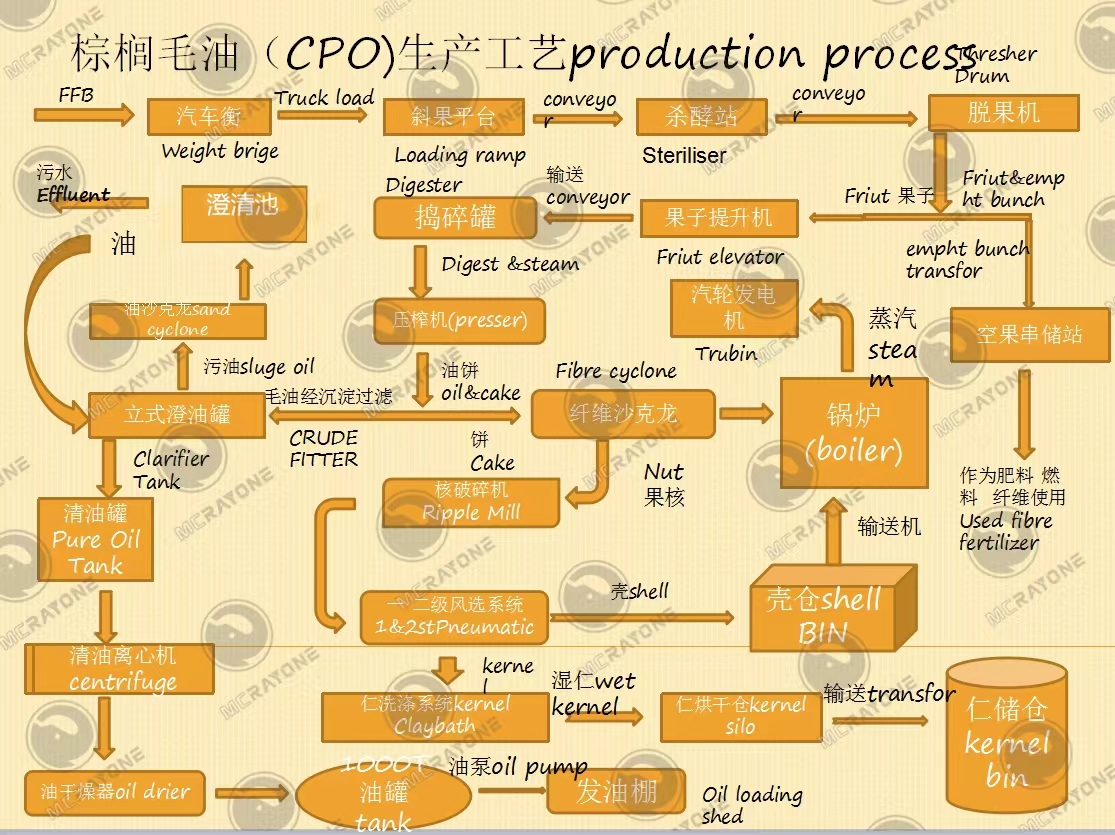Palm oil extraction process
Palm oil is an edible vegetable oil derived from the mesocarp (reddish pulp) of the fruit of the oil palms. The oil is used in food manufacturing, in beauty products, and as biofuel. Palm oil accounted for about 36% of global oils produced from oil crops in Demand has also increased for other uses, such as cosmetics and biofuels, creating more demand on the supply encouraging the growth of palm oil plantations in tropical countries.

Modern palm oil production technology includes the following stages:
Getting fresh oil palm fruits
Fresh fruits are harvested on the plantation and transferred to the plant for further processing within 24 hours. At the initial stage, the fruits are weighed and unloaded into receiving containers.
Sterilization
The resulting bunches of oil palm are sent for sterilization to remove litter and insects. Sterilization is carried out, as a rule, with superheated steam. Superheated steam treatment further improves oil extraction. The sterilized bunches of oil palm are sent to the threshing machine.
Threshing
In the process of threshing, fresh fruits are separated from the bunch, which later go to the next stage — digestion.
Digestion
In the process of digestion, fresh fruits are subjected to heat treatment. Its main purpose is to improve the release of oil from the plant cell. Thus, the fruits are prepared for further pressing. A commonly used digester consists of a cylindrical vessel with steam heating, equipped with a central rotating shaft carrying a number of blades (stirring).
Pressing
Palm oil extraction is carried out by mechanical pressing on a screw extruder. After pressing, the raw palm oil is sent to the washing stage.
filter
After pressing,add 10-20% hot water or steam to dissolve impurities in the crude oil, usually in a vertical container. clarification process, the oil is separated from the trapped water-soluble impurities. The oil-water mixture is then sent to a Vibrating filter to pre-separate the water from the oil, after which the oil is dried to remove residual moisture. Crude palm oil is an independent product.
Purification (refining)
For refining purposes, crude palm oil is treated with superheated steam. Next, the oil is sent to the bleaching apparatus. The bleached oil enters the deodorization column. The deodorization column is a closed cylindrical container with disc-shaped disc-shaped and annular perforated nozzles inside. To improve the refining process, the deodorization column operates under vacuum and at high temperature.
Fractionation
Due to the fact that each triacylglyceride has its own physico-chemical properties and its melting point, fractions are formed. The main type of palm oil processing is fractionation, which results in liquid and solid fractions. Oleic fraction is a liquid fraction of palm oil with a melting point of 19-24 °C. The stearin fraction is a solid fraction of palm oil with a melting point of 44-54 °C. In addition to olein and stearin, there are other fractions of palm oil, for example, superolein with a higher content of oleic acid up to 46% and a reduced content of palmitic acid or olein of double fractionation (melting point 13-17 ° C), the average fraction is 32-38 °C.
Palm Oil Refining&Fractionation Workshop Process Description
Clay
↓
Crude Palm Oil→Degumming→Drying&Dehydrating→Decoloring→Filtering→Deaerator→
↑ ↓
Phosphoric Acid Waste Clay
Deacidifing&Deodorizing→Fractionating→Product Oil
↓
Stearin
